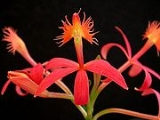
Epidendrum cinnabarinum
Encyclopedia
Epidendrum cinnabarinum, is a terrestrial reed-stemmed Epidendrum
, discovered by the German collector Philipp Salzmann in Bahia
, close to Salvador
, and published by John Lindley in 1831. The specific epithet refers to the vermilion flowers. E. cinnabarinum is similar to (and sometimes confused with) E. fulgens
and E. puniceoluteum, as well as red forms of the other crucifix orchids.
reed-stemmed Epidendrum displays a pseudomonopodial
habit: an individual stem (to 1 m. tall), will grow continuously at the tip for some time bearing fleshy lanceolate green leaves, 2 cm. wide by 10 cm. long, before producing a terminal bloom spike, which usually equals or exceeds the length of the stem. Nevertheless, the flowers come from the top of the stem (halting its upward growth), and new stems start from buds at the base of the old stems, thus making the plant sympodial, like the rest of the subtribe Laeliinae
. The inflorescence is a short, highly congested raceme of non-resupinate, ruby red to orange flowers at the end of a long peduncle
covered from its base through much of its length with tight imbricate sheathes. The deeply lacerate trilobate lip is adnate to the end of the column, with an orange region surrounding the end of the column, a pair of tubercles on either side of the column, and a keel or carina between the tubercles. Unlike some of the crucifix orchids, E. cinnabarinum does not tolerate temperatures below 2°C.
The diploid chromosome
number of E. cinnabarinum has been determined as 2n = ~240, the haploid chromosome number as 108—124.
Epidendrum
Epidendrum , abbreviated Epi in horticultural trade, is a large neotropical genus of the orchid family. With more than 1,100 species, some authors describe it as a mega-genus. The genus name refers to its epiphytic growth habit...
, discovered by the German collector Philipp Salzmann in Bahia
Bahia
Bahia is one of the 26 states of Brazil, and is located in the northeastern part of the country on the Atlantic coast. It is the fourth most populous Brazilian state after São Paulo, Minas Gerais and Rio de Janeiro, and the fifth-largest in size...
, close to Salvador
Salvador, Bahia
Salvador is the largest city on the northeast coast of Brazil and the capital of the Northeastern Brazilian state of Bahia. Salvador is also known as Brazil's capital of happiness due to its easygoing population and countless popular outdoor parties, including its street carnival. The first...
, and published by John Lindley in 1831. The specific epithet refers to the vermilion flowers. E. cinnabarinum is similar to (and sometimes confused with) E. fulgens
Epidendrum fulgens
Epidendrum fulgens is a crucifix orchid native to Brazil. Like E. secundum, with which it has been found to hybridize in habitats disturbed by human activity, E. fulgens flowers are non-resupinate and are born in a congested racime at the end of a long spike...
and E. puniceoluteum, as well as red forms of the other crucifix orchids.
Description
This sympodialSympodial
Sympodial means "with conjoined feet", and in biology is often used to refer to the outward morphology or mode of growth of organisms.-In botany:...
reed-stemmed Epidendrum displays a pseudomonopodial
Monopodial
Vascular plants with monopodial growth habits grow upward from a single point. They add leaves to the apex each year and the stem grows longer accordingly...
habit: an individual stem (to 1 m. tall), will grow continuously at the tip for some time bearing fleshy lanceolate green leaves, 2 cm. wide by 10 cm. long, before producing a terminal bloom spike, which usually equals or exceeds the length of the stem. Nevertheless, the flowers come from the top of the stem (halting its upward growth), and new stems start from buds at the base of the old stems, thus making the plant sympodial, like the rest of the subtribe Laeliinae
Laeliinae
Laeliinae is a Neotropical subtribe including 40 orchid genera, such as Brassavola, Laelia, Sophronitis, and Cattleya. The genus Epidendrum is the largest within this subtribe, containing about 1500 species...
. The inflorescence is a short, highly congested raceme of non-resupinate, ruby red to orange flowers at the end of a long peduncle
Peduncle (botany)
In botany, a peduncle is a stem supporting an inflorescence, or after fecundation, an infructescence.The peduncle is a stem, usually green and without leaves, though sometimes colored or supporting small leaves...
covered from its base through much of its length with tight imbricate sheathes. The deeply lacerate trilobate lip is adnate to the end of the column, with an orange region surrounding the end of the column, a pair of tubercles on either side of the column, and a keel or carina between the tubercles. Unlike some of the crucifix orchids, E. cinnabarinum does not tolerate temperatures below 2°C.
The diploid chromosome
Chromosome
A chromosome is an organized structure of DNA and protein found in cells. It is a single piece of coiled DNA containing many genes, regulatory elements and other nucleotide sequences. Chromosomes also contain DNA-bound proteins, which serve to package the DNA and control its functions.Chromosomes...
number of E. cinnabarinum has been determined as 2n = ~240, the haploid chromosome number as 108—124.

